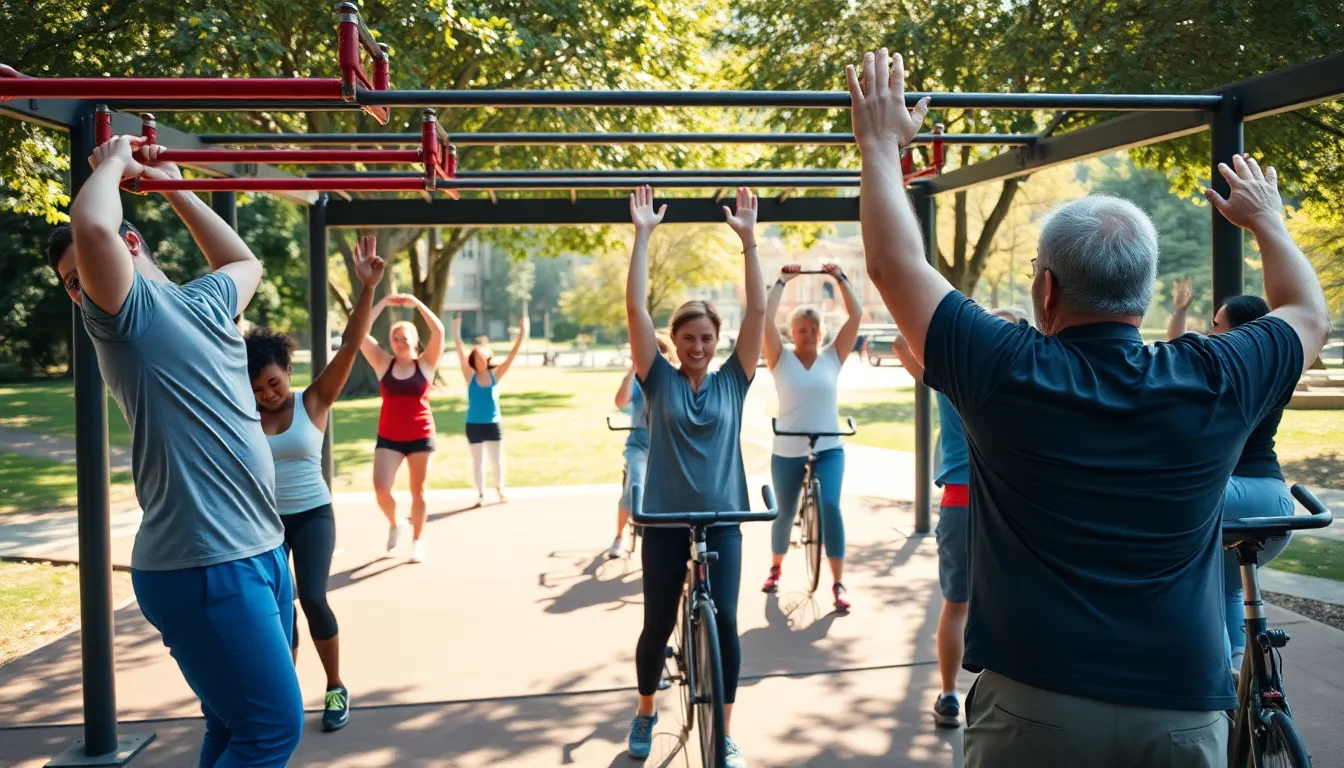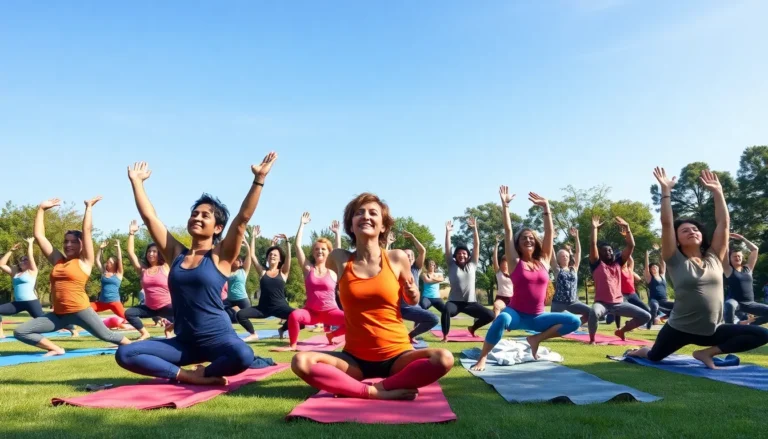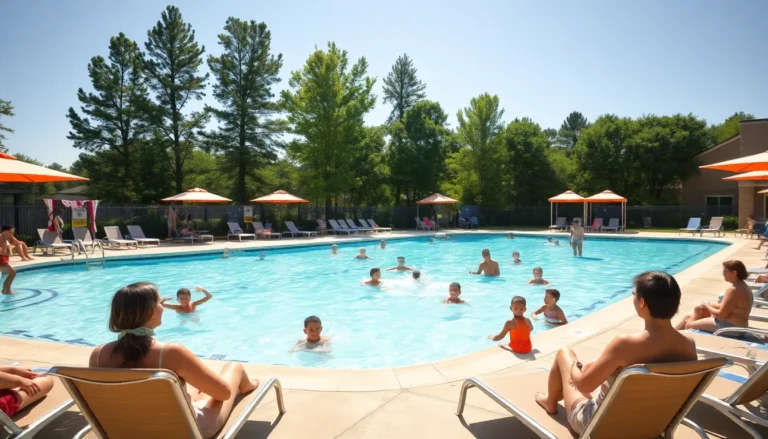Table of Contents
ToggleImagine trading the stuffy confines of a traditional gym for the great outdoors. An outdoor gym offers a refreshing twist to the mundane workout routine, letting you soak up sunshine while breaking a sweat. It’s like having a personal trainer who doubles as a nature enthusiast—no membership fees required!
Overview of Outdoor Gyms
Outdoor gyms offer a unique fitness experience that combines nature with exercise. Located in parks and recreational areas, they typically feature various fitness equipment designed for strength training and cardio. These facilities provide access to equipment like pull-up bars, climbing frames, and stationary bikes, encouraging users to engage in a full-body workout.
Weather plays a significant role in outdoor gym usage. Individuals can enjoy fresh air and natural light, enhancing motivation and overall well-being. Exercising outside often leads to improved mood and energy levels, allowing for a rewarding fitness experience.
Cost effectiveness appears as another advantage. Outdoor gyms typically operate without membership fees, making fitness accessible to all. Users save money while enjoying the same benefits as traditional gyms. Communities benefit as well, with outdoor gyms promoting physical health and social interaction among residents.
User engagement varies, with individuals preferring different exercise styles. Some enjoy group workouts, while others opt for solo sessions. Outdoor environments foster diverse activities such as yoga, circuit training, and running, accommodating various interests.
Development of outdoor gym spaces continues to increase globally. City planners recognize the importance of incorporating these facilities into urban designs. By prioritizing outdoor fitness options, communities enhance public health and promote active lifestyles.
Regular usage of outdoor gyms presents opportunities for users to connect with nature. Research indicates that exercising outdoors can reduce stress levels, improve focus, and promote mental clarity. Participants who exercise in green spaces often report greater satisfaction compared to those in enclosed settings.
Benefits of Using an Outdoor Gym

Outdoor gyms offer numerous advantages that enhance overall well-being. Engaging with fitness in natural settings provides both physical and mental health benefits.
Physical Health Benefits
Regular use of outdoor gyms promotes cardiovascular health due to the variety of equipment and exercises available. Equipment like pull-up bars and stationary bikes facilitate strength and endurance training. Exercisers tend to engage in full-body workouts, which increase muscular strength and flexibility. Many outdoor gym enthusiasts enjoy exercises tailored to their fitness levels. This accessibility encourages more individuals to participate in physical activities. Consistent workouts outdoors also improve coordination and balance, crucial for overall fitness.
Mental Health Benefits
Spending time in nature while exercising significantly boosts mental well-being. The presence of natural light and fresh air enhances mood and reduces feelings of anxiety. Engaging in outdoor workouts can lead to increased energy levels and improved focus. Many people experience greater satisfaction when exercising in stimulating environments. Social interaction among users fosters a sense of community, which supports mental health. Research shows that outdoor exercise contributes to lower stress levels, further enhancing overall happiness.
Popular Features of Outdoor Gyms
Outdoor gyms offer a range of features that enhance the exercise experience. Users can expect various amenities that appeal to fitness enthusiasts of all levels.
Equipment Types
Equipment types available in outdoor gyms typically include strength and cardio machines. Commonly found items feature pull-up bars, parallel bars, and stationary bikes. Many spaces also provide balance beams and resistance training tools. These diverse options encourage varied workouts, allowing participants to target different muscle groups. Additionally, outdoor gyms often incorporate modular systems designed for functional training, enhancing versatility for users.
Accessibility and Location
Accessibility and location play key roles in the popularity of outdoor gyms. Positioned in parks and recreational areas, these facilities ensure easy access for communities. Users find that proximity to residential areas fosters higher engagement rates. Often designed for all skill levels, outdoor gyms eliminate barriers often associated with traditional gyms. Access to these spaces promotes inclusivity, encouraging individuals to embrace an active lifestyle thanks to their free services. Weather permitting, these locations draw in crowds by offering unique outdoor experiences.
Outdoor Gym vs. Indoor Gym
Outdoor gyms offer distinct advantages compared to traditional indoor gyms. Fresh air is a significant benefit of outdoor workouts. Sunlight exposure contributes to vitamin D production, which enhances mood and energy levels.
Accessibility plays a key role in participation rates. Outdoor gyms, located in parks and community spaces, lack membership fees, making fitness available to everyone. This contrasts with indoor gyms, which often impose monthly fees and contracts.
Variety in workout environments enhances motivation. Exercisers frequently experience increased satisfaction from engaging with nature, as it creates a more dynamic workout experience. Moreover, outdoor gyms often feature equipment such as pull-up bars, resistance tools, and stationary bikes for diverse exercise options, unlike some indoor facilities with limited training equipment.
Social interactions flourish in outdoor settings. Many users prefer group workouts in parks, fostering a sense of community not typically found in enclosed spaces. In contrast, indoor gyms can feel isolating, with people focusing on individual routines.
Mental health benefits emerge prominently from outdoor exercise. Research confirms that natural settings help lower stress and anxiety, promoting a more positive mindset. Users at outdoor gyms often report increased happiness and satisfaction compared to indoor workouts.
Weather impacts participation, but many find motivation in various climates. While inclement weather might deter outdoor use, favorable conditions draw crowds, enhancing the overall experience. Indoor gyms provide a consistent environment but lack the invigorating elements of nature.
Outdoor gyms provide unique benefits that enhance physical and mental well-being. Comparatively, indoor gyms may offer climate control and extensive facilities, yet they cannot replicate the refreshing experience of exercising outside.
Outdoor gyms present an invigorating and accessible way to stay fit. By merging exercise with the beauty of nature, they create an environment that boosts both physical and mental well-being. The absence of membership fees opens doors for everyone to engage in fitness without financial barriers.
As urban planners continue to recognize their value, outdoor gyms are becoming integral to community health initiatives. They not only promote active lifestyles but also foster social connections among users. Embracing the outdoors while working out can lead to a more fulfilling fitness journey, enhancing motivation and satisfaction. The benefits of outdoor gyms are undeniable, making them a compelling choice for anyone looking to improve their overall health and happiness.







